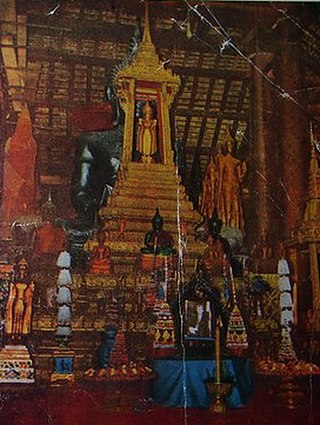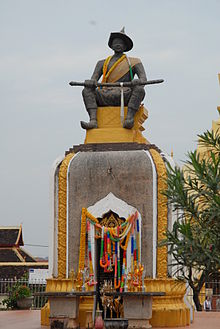
Lan Xang or Lancang was a Lao kingdom that held the area of present-day Laos from 1353 to 1707. For three and a half centuries, Lan Xang was one of the largest kingdoms in Southeast Asia. The kingdom is the basis for Laos's national historic and cultural identity.

The Phra Bang, Lao is the palladium of Laos. The Lao-language name for the image has been transliterated in a number of ways, including "Pra Bang," "Prabang," "Phabang" and "Pha Bang." The statue is an 83 cm-high standing Buddha with palms facing forward, cast using thong, an alloy of bronze, gold, and silver. According to local lore, it was cast in Ceylon sometime between the 1st and 9th century. However, the features of the image suggest a much later Khmer origin.
Lao ceramics refers to ceramic art and pottery designed or produced as a form of Lao art. The tradition of Lao ceramics dates back to the third millennium BCE. Pottery and ceramics were an essential part of the trade between Laos and its neighbours.

Lao Buddhist sculptures were created by the Lao people of Southeast Asia. They are typically made of bronze, although gold and silver images can also be found. The Vat Manorom is believed to be the oldest colossal Lao Buddhist sculpture. Today, the sculpture gardens of Luang Pu Bunleua Sulilat provide a modern twist to the ancient tradition.

The Nagas are a divine, or semi-divine, race of half-human, half-serpent beings that reside in the netherworld (Patala), and can occasionally take human or part-human form, or are so depicted in art. A female naga is called a Nagi, or a Nagini. According to legend, they are the children of the sage Kashyapa and Kadru. Rituals devoted to these supernatural beings have been taking place throughout South Asia for at least 2,000 years. They are principally depicted in three forms: as entirely human with snakes on the heads and necks, as common serpents, or as half-human, half-snake beings in Hinduism, Buddhism, and Jainism.

Nong Khai is a city in northeast Thailand. It is the capital of Nong Khai province. Nong Khai city is located in Mueang Nong Khai district.

Laos developed its culture and customs as the inland crossroads of trade and migration in Southeast Asia over millennia. As of 2012 Laos has a population of roughly 6.4 million spread over 236,800 km2, yielding one of the lowest population densities in Asia. Yet the country of Laos has an official count of over forty-seven ethnicities divided into 149 sub-groups and 80 different languages. The Lao Loum have throughout the country's history comprised the ethnic and linguistic majority. In Southeast Asia, traditional Lao culture is considered one of the Indic cultures.

'Phra Lak Phra Ram' is the national novel of the Lao people, and is the Lao adaptation of the Dasaratha Jataka, a story narrating one of the previous life of Buddha as a Bodhisatta named Rama. It was brought to Laos and other Southeast Asia by propagation of Buddhism. The story reached Laos much later than Cambodia and Thailand (Siam) and thus was affected by local adaptation.

Wat Si Saket is a Buddhist wat in Vientiane, Laos. It is situated on Lan Xang Road, on the corner with Setthathirat Road, to the northwest of Haw Phra Kaew, which formerly held the Emerald Buddha.
Douangdeuane Bounyavong, pen name Dok Ked(Dō̜kkēt), is a Laotian writer. She married Outhine Bounyavong, known for a contemporary Laotian fiction writer. She has written poems, several textiles books and novels and transcribed numerous traditional stories, of which the best-known is Kam Pha Phi Noi. She is engaged in literacy, e.g. by participating at the Big Brother Mouse project, and participates on running a publishing house and a shop providing children's books in Lao language.

Haw Phra Kaew, also written as Ho Prakeo, Hor Pha Keo and other similar spellings, is a former temple in Vientiane, Laos. It is situated on Setthathirath Road, to the southeast of Wat Si Saket. It was first built in 1565 to house the Emerald Buddha, but has been rebuilt several times. The interior now houses a museum of religious art and a small shop.

Buddha Park, also known as Xieng Khuan, is a sculpture park 25 km southeast from Vientiane, Laos in a meadow by the Mekong River. Although it is not a temple (Wat), it may be referred to as Wat Xieng Khuan since it contains numerous religious images. The name Xieng Khuan means Spirit City. The park contains over 200 Hindu and Buddhist statues. The socialist government operates Buddha Park as a tourist attraction and public park.

Vientiane is the capital and largest city of Laos. Comprising the five urban districts of Vientiane Prefecture, the city is located on the banks of the Mekong, right at the border with Thailand. Vientiane was the administrative capital during French rule and, due to economic growth in recent times, is now the economic center of Laos. The city had a population of 1,001,477 as of the 2023 Census.

Wat Ong Teu Mahawihan is one of many Buddhist monasteries in the city of Vientiane in Laos. This name is given to the temple due to the large, bronze Phra Ong Teu Buddha image that is in the temple: the largest Buddha in Vientiane. This temple was initially constructed by King Setthathirath I in the 16th century when Laos was being bombarded by the Burmese, but was later demolished during a foreign invasion. Thus, it may have gone through many reconstructions during the 19th or 20th century to attain the appearance it has today.

Vientiane province is a province of Laos in the country's northwest. As of 2015 the province had a population of 419,090. Vientiane province covers an area of 15,610 square kilometres (6,030 sq mi) composed of 11 districts. The principal towns are Vang Vieng and Muang Phôn-Hông.

Vientiane is a prefecture of Laos, in the northwest Laos. The national capital, Vientiane, is in the prefecture. The prefecture was created in 1989, when it was split off from Vientiane province.

Luang Prabang is a province in northern Laos. Its capital of the same name, Luang Prabang, was the capital of the Lan Xang Kingdom during the 13th to 16th centuries. It is listed since 1995 by UNESCO as a World Heritage Site for unique architectural, religious and cultural heritage, a blend of the rural and urban developments over several centuries, including the French colonial influences during the 19th and 20th centuries. The province has 12 districts. The Royal Palace, the national museum in the capital city, and the Phou Loei Protected Reserve are important sites. Notable temples in the province are the Wat Xieng Thong, Wat Wisunarat, Wat Sen, Wat Xieng Muan, and Wat Manorom. The Lao New Year is celebrated in April as The Bun Pi Mai.
The people of Laos have a rich literary tradition dating back at least six hundred years, with the oral and storytelling traditions of its peoples dating back much earlier. Lao literature refers to the written productions of Laotian peoples, its émigrés, and to Lao-language works. In Laos today there are over forty-seven recognized ethnic groups, with the Lao Loum comprising the majority group. Lao is officially recognized as the national language, but owing to the ethnic diversity of the country the literature of Laos can generally be grouped according to four ethnolinguistic families: Lao-Tai (Tai-Kadai); Mon-Khmer (Austroasiatic); Hmong-Mien (Miao-Yao), and Sino-Tibetan. As an inland crossroads of Southeast Asia the political history of Laos has been complicated by frequent warfare and colonial conquests by European and regional rivals.

Sang Sinxay is a Lao epic poem written by Pang Kham. It tells the story of the hero Sinxay (ສິນໄຊ) who goes on a quest to rescue his aunt Soumountha (ສູມຸນທາ) who was abducted by the demon Nyak Koumphan (ຍັກກູມພັນ). The poem is believed to have been written sometime between the mid-16th and the end of the 17th century in the Lao kingdom of Lan Xang. Sang Sinxay is considered one of the three masterpieces of Lao literature. The poem is popular in Laos and in the Isan region of Thailand, where its scenes are also depicted on numerous temples.

Lao–Siamese War or the Siamese Invasion of Laos (1778–1779) is the military conflict between Thonburi Kingdom of Siam and the Lao kingdoms of Vientiane and Champasak. The war resulted in all three Lao kingdoms of Luang Phrabang, Vientiane and Champasak becoming Siamese tributary vassal kingdoms under Siamese suzerainty and domination in Thonburi and the subsequent Rattanakosin Period.



















